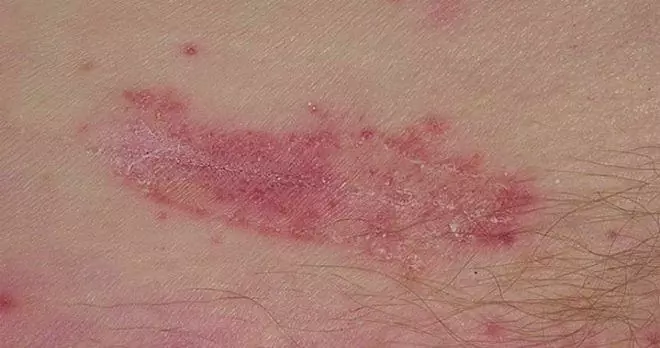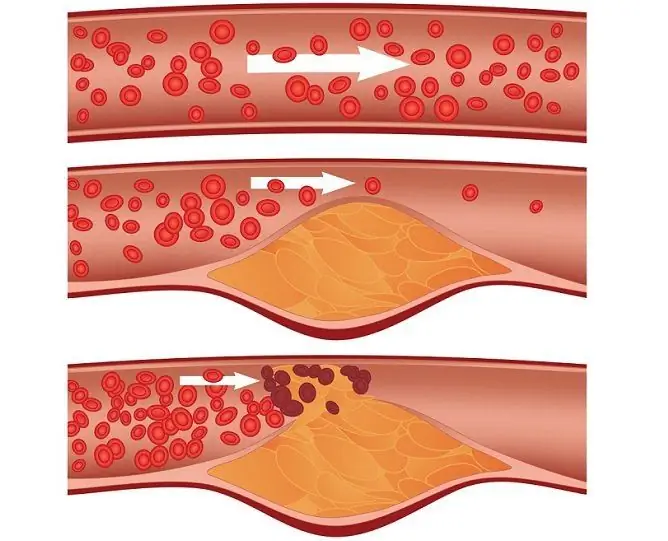- Author Rachel Wainwright [email protected].
- Public 2023-12-15 07:39.
- Last modified 2025-11-02 20:14.
Vaginal candidiasis
The content of the article:
- Causes of vaginal candidiasis and risk factors
- Forms of the disease
- Symptoms of vaginal candidiasis
- Diagnostics
- Treatment of vaginal candidiasis
- Possible complications and consequences
- Forecast
- Prevention
Vaginal candidiasis (thrush) is a fungal infection of the vaginal mucosa, which belongs to the most common gynecological diseases of infectious etiology (it is in second place after bacterial vaginosis). In some cases, the pathological process extends to the cervix and vulva. The causative agents of vaginal candidiasis are yeast-like fungi of the genus Candida. Vaginal candidiasis is most often recorded in women of reproductive age, especially during pregnancy (in 30-40% of pregnant women). In the period before the onset of the menstrual cycle, as well as in postmenopausal women, the disease is much less common. According to statistics, approximately 70% of women have had at least one episode of vaginal candidiasis throughout their lives, while in 15-20% of cases the disease becomes chronic.

The causative agent of vaginal candidiasis is yeast-like fungi of the genus Candida
Causes of vaginal candidiasis and risk factors
Microscopic yeast-like fungi of the genus Candida are conditionally pathogenic microorganisms that are part of the normal vaginal microflora, and usually they do not cause inflammation. For this reason, vaginal candidiasis does not belong to sexually transmitted diseases (STDs), although an infectious agent can also be transmitted during intercourse. In most cases (75-90%), the causative agent of vaginal candidiasis is Candida albicans, which has a great pathogenic potential.
The development of candidiasis is facilitated by immunodeficiency states, the presence of chronic diseases, malignant neoplasms, metabolic disorders, changes in hormonal levels (this explains the widespread prevalence of vaginal candidiasis in pregnant women), the use of certain medications (antibiotics, steroid anti-inflammatory drugs, etc.), allergies, poor nutrition, chronic or severe one-time stress, a sharp change in the climatic zone. In addition, the causes of vaginal candidiasis can be non-compliance with the rules of personal hygiene, improper use of hygiene products (gynecological tampons, pads), as well as wearing underwear made of synthetic materials.
Forms of the disease
There are three clinical forms of vaginal candidiasis:
- asymptomatic candidacy (there are no clinical manifestations of the disease, but the number of Candida fungi significantly exceeds the norm);
- acute vaginal candidiasis;
- chronic vaginal candidiasis (the duration of the disease is more than 2 months).
Symptoms of vaginal candidiasis
With candidacy, the patient, as a rule, does not present any complaints, the pathology is discovered by chance, when analyzing the contents of the vagina for another reason.
With the development of an acute form of vaginal candidiasis, thick grayish-white discharge of a cheesy appearance from the vagina is noted, which has a sour or sour milk smell. The affected mucous membrane is hyperemic, edematous and prone to injury. On it, delimited foci of cheesy plaque and films appear, which are able to merge with each other and are removed with difficulty. When removed, a shiny eroded surface is found underneath. With the growth of the inflammatory process, the films begin to be easily separated and removed from the genital tract.

In the acute form of vaginal candidiasis, a woman feels discomfort, burning and itching in the vaginal area
In the acute form, the external genital organs are usually involved in the pathological process. Typical symptoms of vaginal candidiasis are burning and itching sensations, hyperemia and swelling in the labia majora and labia minora, as well as in the perineum up to the anus. The itching sensation can cause scratching and secondary infection. The discomfort usually intensifies during menstruation, after intercourse, hypothermia, physical exertion, and contact with water. There may be pain when urinating. Thrush symptoms sometimes disappear spontaneously during menstrual bleeding.
Often, candidiasis occurs in an erased form. In this case, clinical manifestations may be weakly expressed, or the patient has only some of the listed symptoms.
In chronic vaginal candidiasis, characteristic cheesy discharge is most often absent. There is hyperemia of the affected vaginal mucosa, a small amount of films and dry erosions. The mucous membrane becomes atrophic and flabby, hemorrhagic rashes can occur on it. The chronic form of the disease can last for a long time, for years or even decades. Relapses of the disease usually occur about four times a year, with clinical manifestations often beginning about a week before the onset of menstruation. An exacerbation of chronic candidiasis has symptoms similar to the acute form of the disease.
Diagnostics
The diagnosis of vaginal candidiasis is established by a gynecologist according to the collection of complaints, anamnesis, and examination. The diagnosis is confirmed by isolating a culture of microscopic yeast-like fungi of the genus Candida by cultural methods of diagnosing vaginal discharge with a simultaneous determination of the sensitivity of the pathogen to antimycotic drugs.

To diagnose vaginal candidiasis, you should contact your gynecologist
When examining the cervix and vagina using a gynecological mirror, pathological changes typical for vaginal candidiasis are determined. When the affected area is stained with Lugol's solution, a pronounced vascular pattern and small-dot blotches appear.
With frequent relapses of vaginal candidiasis, the patient is advised to undergo a complete medical examination in order to identify endocrine or other chronic diseases. The presence of persistent vaginal candidiasis that does not respond well to treatment may indicate the presence of diabetes mellitus.
If necessary, bacteriological analysis of urine and feces, determination of the concentration of glucose in the blood, ultrasound examination of the pelvic organs and abdominal cavity, etc.

With vaginal candidiasis, fungi of the genus Candida are found in the mucus discharge from the vagina
Differential diagnosis of vaginal candidiasis is carried out with bacterial vaginosis, as well as with STDs. At the same time, to exclude STDs, it may be necessary to conduct an enzyme immunoassay, an immunofluorescence reaction, and a polymerase chain reaction.
Treatment of vaginal candidiasis
Treatment of vaginal candidiasis is complex, it includes exposure to the pathogen, elimination of provoking factors, if necessary - therapy of concomitant diseases, strengthening local and general immunity. At the time of treatment, a diet is recommended with the exception of confectionery, spicy, smoked, fried foods and alcohol from the diet. The amount of sugar consumed should be reduced to a minimum.

For vaginal candidiasis, you should limit your sugar intake
For vaginal candidiasis, both local and systemic antimycotic drugs are used, the choice of which is carried out depending on the severity of the disease. Local therapy is effective in the initial onset of the disease, acute, as well as uncomplicated course. In the chronic form of vaginal candidiasis, systemic antimycotic drugs are taken in courses. The general treatment of chronic vaginal candidiasis can be supplemented by the use of antiseptic and anti-inflammatory drugs in the form of douching and baths.
In the chronic form of vaginal candidiasis, physiotherapeutic methods are widely used, such as magnetotherapy, electrophoresis, laser therapy, darsonvalization, therapy with sinusoidal modulated currents, etc.
Treatment of acute vaginal candidiasis can last from one day to a week and is effective in 80-90% of cases. Compliance with the rules of personal hygiene is of no small importance.

During pregnancy, vaginal candidiasis is treated with topical drugs
Treatment of vaginal candidiasis during pregnancy is carried out taking into account the existing contraindications. In pregnant women, drug therapy for vaginal candidiasis is usually carried out with topical preparations (in the form of suppositories, vaginal tablets, ointments, etc.). Systemic treatment is resorted to only in case of ineffectiveness of local therapy, while antimycotic drugs that do not have an embryotoxic effect are preferred.
The disappearance of clinical signs of vaginal candidiasis is not always a criterion for cure. For this reason, after the therapy, a repeated laboratory examination of the vaginal smear is recommended.
Possible complications and consequences
Vaginal candidiasis, especially in the case of the development of a chronic form of the disease, can be complicated by the spread of the pathological process to nearby structures with the development of cervicitis, urethritis, cystitis, in severe cases it can cause infertility.

Long-term chronic vaginal candidiasis can cause infertility
Complications of vaginal candidiasis during pregnancy and childbirth are the threat of termination of pregnancy, chorioamnionitis, premature rupture of amniotic fluid, intrauterine infection of the fetus, the birth of a low birth weight child, the development of wound infection of the birth canal, as well as endometritis in the postpartum period. Fetal infection can occur both at the prenatal stage of development, and when passing through the birth canal. Over the past decades, the incidence of candidiasis in full-term newborns has increased from 2 to 16%.
Forecast
With timely diagnosis and properly selected treatment, the prognosis is favorable.
Prevention
In order to prevent vaginal candidiasis, it is recommended:
- compliance with the rules of personal hygiene;
- wearing underwear made from natural materials;
- avoiding casual sex;
- adequate treatment of chronic diseases;
- avoiding the uncontrolled use of drugs;
- undergoing regular preventive examinations with a gynecologist;
- balanced diet.
YouTube video related to the article:

Anna Aksenova Medical journalist About the author
Education: 2004-2007 "First Kiev Medical College" specialty "Laboratory Diagnostics".
The information is generalized and provided for informational purposes only. At the first sign of illness, see your doctor. Self-medication is hazardous to health!






